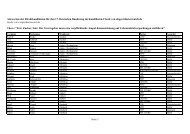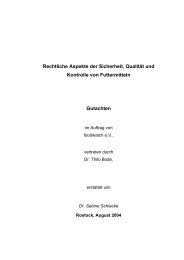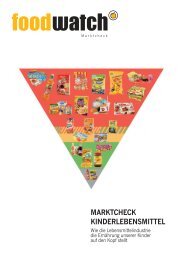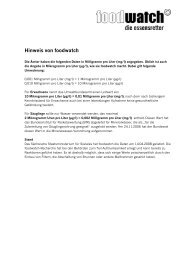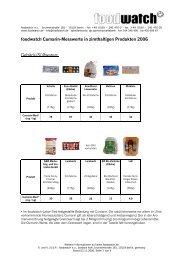Ökobilanz von Danone Activia-Verpackungen aus ... - Foodwatch
Ökobilanz von Danone Activia-Verpackungen aus ... - Foodwatch
Ökobilanz von Danone Activia-Verpackungen aus ... - Foodwatch
Erfolgreiche ePaper selbst erstellen
Machen Sie aus Ihren PDF Publikationen ein blätterbares Flipbook mit unserer einzigartigen Google optimierten e-Paper Software.
IFEU-Heidelberg <strong>Ökobilanz</strong> <strong>von</strong> <strong>Danone</strong> <strong>Activia</strong>-<strong>Verpackungen</strong> 2011 149<br />
Table 1 Relative Global Warming Potentials for different annual crop (corn-soybean-wheat) management systems based on soil<br />
carbon sequestration, agronomic inputs and trace gas fluxes. Units are CO2 equivalents (g/m 2 /year), using IPCC conversion<br />
factors. Negative values indicate global warming mitigation potential through in situ soil sequestration.<br />
Corn-soybean-wheat<br />
rotations<br />
I. Conventional inputs<br />
+ tillage<br />
II. Conventional inputs<br />
+ No-till<br />
III. Reduced inputs +<br />
legume cover + tillage<br />
IV. Organic inputs +<br />
legume cover + tillage<br />
CO2<br />
Soil C<br />
CO2<br />
N fert.<br />
CO2<br />
Lime<br />
CO2<br />
Fuel<br />
Endbericht – Bearbeitungsstand 29. März 2011<br />
N2O CH4 Net<br />
GWP<br />
0 27 23 16 52 -4 114<br />
-110 27 34 12 56 -5 14<br />
-40 9 19 20 60 -5 63<br />
-29 0 0 19 56 -5 41<br />
The study supports a conclusion that all the studied non-conventional tillage systems<br />
increased soil carbon over the decade-long period of the study. This soil carbon<br />
accumulation even characterized the low-input and organic regimes despite the use<br />
of plowing/tilling techniques. In those two cases, the sequestered carbon is likely the<br />
result of the winter cover crop adding unharvested plant biomass to the soil. None of<br />
the cropping systems provided a net reduction in greenhouse gas emissions.<br />
However, no-till conservation tillage performed best in reducing contributions to<br />
global climate change. The no-till system accumulated 30 g C or 110 g CO2/m 2 /year,<br />
which is an average value for no-till rotations in the Mid-west United States.<br />
The average accumulation of carbon in the soil in the twenty-six counties surrounding<br />
the Cargill/NatureWorks production facilities can be estimated at 16 g C/m 2 /year. This<br />
is equivalent to a carbon dioxide fixation of 59 g CO2/m 2 /year.<br />
In light of this data, the following assumptions were made:<br />
- conservation no-till practices are applied on 35.8% of the corn acreage‟s. Soil<br />
carbon accumulation is assumed to be 30 g C/m 2 /year (Case II of Table 1).<br />
- conventional till practices are applied on 15.4% of the corn acreage‟s. The soil<br />
carbon accumulation for these areas is assumed to be 0 g C/m 2 /year (Case I of<br />
Table 1).<br />
- For the remaining acreage (48.7%), it is assumed that mulching and reducing<br />
tilling are practiced, with a soil carbon accumulation of 10.9 g C/m 2 /year (Case III<br />
of Table 1).



